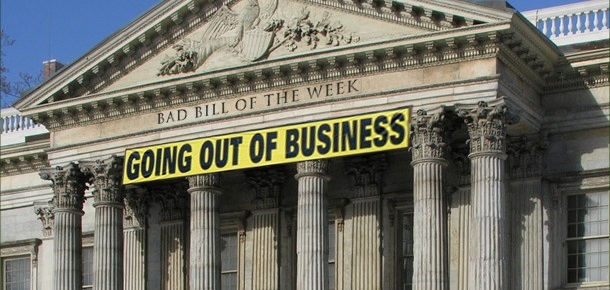Publisher's note: This post, by Brian Balfour, was originally published in the Bad Bill of the Week section(s) of Civitas's online edition.
House Resolution 836, Support Restoration of Glass-Steagall Act, is a fact-free proclamation seeking to perpetuate a harmful myth surrounding the financial collapse of 2008. Sponsored by Reps.
Jeff Collins (R-Nash),
Mitchell Setzer (R-Catawba),
Robert Brawley (R-Iredell), and
Rodney Moore (D-Mecklenburg), the Resolution would have the General Assembly urge "the United States Congress to enact legislation that would reinstate the separation of commercial and investment banking functions that were in effect under the Glass-Steagall Act."
The premise behind this resolution is the ill-informed myth that "the Glass-Steagall Act was repealed in 1999, partially contributing to the greatest speculative bubble and worldwide recession since the Great Depression of 1933." Neither one of these statements is remotely true.

For sake of background, the Glass-Steagall Act refers to the Banking Act of 1933 which, among other things, attempted to keep separate the functions of commercial banks and investment banks.
The so-called "repeal" of Glass-Steagall took place in 1999 when President Clinton signed the Gramm-Leach-Bliley Act (GLBA).
But it is untrue that GLBA actually "repealed" the Glass-Steagall Act. As financial policy expert for the American Enterprise Institute and former general counsel to the U.S. Treasury Department Peter Wallison points out:
Glass-Steagall was never repealed. It is still applicable to insured banks and forbids them from underwriting or dealing in securities. What was repealed in 1999 were the sections of Glass-Steagall that prohibited insured banks from being affiliated with firms--commonly called investment banks--that engaged in underwriting and dealing in securities. (emphasis added)
So Glass-Steagall was never repealed, it merely was amended to remove two of its sections.
Moreover, the removal of those sections did not even "partially contribute" to the financial crisis and the recession that followed. As
President Clinton said in 2008, "I don't see that signing that bill had anything to do with the current crisis." Wallison similarly concludes, "(I)f Glass-Steagall had never been amended in 1999, the financial crisis of 2008 would have happened exactly as it did. Those who spend their time blaming Glass-Steagall's repeal for the financial crisis need to think again."
Still, there are those that insist that removal of two sections of Glass-Steagall somehow is to blame for overly risky behavior by banks, causing the financial collapse due to the intermingling of commercial and investment banking activities. If this narrative were true, it would follow that those institutions that failed would be those that combined commercial and investment banking activities.
Reality, however, shows otherwise. As noted in the
Washington Post:
Facts such as that Bear Stearns, Lehman Brothers and Merrill Lynch -- three institutions at the heart of the crisis -- were pure investment banks that had never crossed the old line into commercial banking. The same goes for Goldman Sachs, another favorite villain of the left.
The infamous AIG? An insurance firm. New Century Financial? A real estate investment trust. No Glass-Steagall there.
Two of the biggest banks that went under, Wachovia and Washington Mutual, got into trouble the old-fashioned way - largely by making risky loans to homeowners. Bank of America nearly met the same fate, not because it had bought an investment bank but because it had bought Countrywide Financial, a vanilla-variety mortgage lender.
Meanwhile, J.P. Morgan and Wells Fargo -- two large banks with big investment banking arms -- resisted taking government capital and arguably could have weathered the crisis without it.
And as best-selling economist Tom Woods points out: "The (repeal of) Glass-Steagall-did-it crowd is the same crowd that likes to claim Canada avoided the worst of the U.S. crisis because it was so much better regulated. But they can't have it both ways -- Canada did not have a Glass-Steagall law!"
HR 836 is an ill-informed attempt to revive a false narrative - namely that it was "de-regulation" of the banking system that caused the financial crisis. The premises behind the resolution are false and easily refutable with a minimum amount of research. For these reasons, HR 836 is this week's Bad Bill of the Week.
























